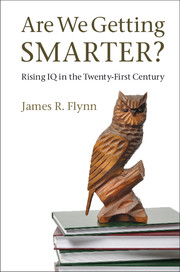Book contents
- Frontmatter
- Contents
- List of Figures
- List of Tables
- List of Boxes
- Acknowledgments
- 1 Opening windows
- 2 IQ and intelligence
- 3 Developing nations
- 4 Death, memory, and politics
- 5 Youth and age
- 6 Race and gender
- 7 The sociological imagination
- 8 Progress and puzzles
- Appendix I IQ trends
- Appendix II Capital cases and comparing the WAIS-III IQs of various nations
- Appendix III Adult/child IQ trends and bright taxes/bonuses
- Appendix IV Gender and Raven’s
- Appendix V Wonderful paper on causes of Raven’s gains
- References
- Subject index
- Name index
Appendix III - Adult/child IQ trends and bright taxes/bonuses
Published online by Cambridge University Press: 05 November 2012
- Frontmatter
- Contents
- List of Figures
- List of Tables
- List of Boxes
- Acknowledgments
- 1 Opening windows
- 2 IQ and intelligence
- 3 Developing nations
- 4 Death, memory, and politics
- 5 Youth and age
- 6 Race and gender
- 7 The sociological imagination
- 8 Progress and puzzles
- Appendix I IQ trends
- Appendix II Capital cases and comparing the WAIS-III IQs of various nations
- Appendix III Adult/child IQ trends and bright taxes/bonuses
- Appendix IV Gender and Raven’s
- Appendix V Wonderful paper on causes of Raven’s gains
- References
- Subject index
- Name index
Summary
Box 18 in Chapter 5 compares IQ gains between 1950–51 and 2005 on three subtests of the WAIS and WISC. It is derived from Table AIII1. That in turn is based on Tables AII2 and AII3 in Appendix II.
From Table AIII1, we can derive Table AIII2, which covers the full 54.25 years and puts the subtests in a hierarchy running from the subtest on which adult gains most exceeded child gains (vocabulary) to the subtest on which child gains most exceeded adult gains (block design). Box 18 in Chapter 5 includes only three of these subtests: vocabulary, information, and arithmetic. These tables are on pages 246 and 247.
Figure 2 in Chapter 5 showed how tertiary education and the parent/child vocabulary gap increased between 1947 and 2002. I will reproduce that figure here and add some comments (see Figure 4 ) on page 247.
The “index of some tertiary education” shows the rising percentage of Americans aged 25 years and over who had one year of tertiary education or more. The actual percentages are as follows: 12.1% in 1947; 22.9% in 1972; 38.4% in 1989; and 52.0% in 2002 (Current Population Surveys, 1940–2007). The slope was contrived simply to show a rise in the percentage with some tertiary education about double the vocabulary gain for adults over the same period. It has no more justification than the fact that the correlation between the two cannot be perfect. The rationale of referring to WAIS vocabulary gains as the gains of “parents” and the WISC vocabulary gains as the gains of “their children is described in the text.
- Type
- Chapter
- Information
- Are We Getting Smarter?Rising IQ in the Twenty-First Century, pp. 245 - 258Publisher: Cambridge University PressPrint publication year: 2012



